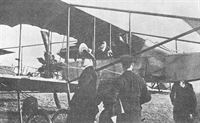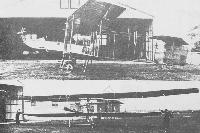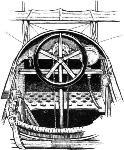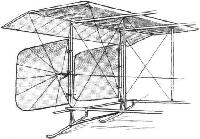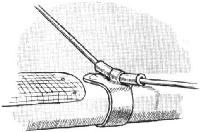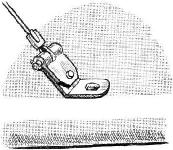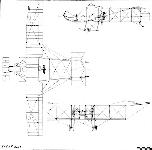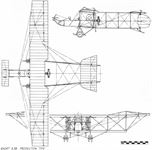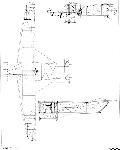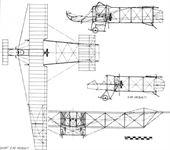C.Barnes Short Aircraft since 1900 (Putnam)
Short Pusher Biplanes (1910-14)
<...>
... Malone made one more flight from H.M.S. London on 9 July, but later that day S.38 was wrecked while being hoisted aboard from its lighter in a choppy sea.
The remains were returned to Eastchurch and emerged from the factory in August completely rebuilt to a new standard, with a nacelle similar to, but longer than, that of Egerton’s S.35, and with the engine raised, the chassis shortened, the gap reduced and the span increased to 52 ft. The new wing extensions were set at a slight dihedral angle and braced by kingposts and wires instead of struts. The tailplane and rear elevator were enlarged and set high, with twin rectangular rudders below, and the front elevator, though carried on the original booms, was much smaller than before. The rudders carried the Naval serial 2 already allotted in June (originally as T.2, while S.34 became T.1 at the same time). In its revised form, S.38 was first flown, with a 70 hp Gnome, by Samson on 30 August, when it climbed to 1,000 ft in eight minutes and subsequently took off with two passengers in addition to the pilot. Thus rebuilt, S.38 became the prototype of a new production series, the ‘S.38-type’, whose works numbers ran from S.54 to S.62. In the production version the wing extensions were slightly tapered (the leading edge being swept back), the front elevator booms were deleted and the elevator was carried on an outrigger on the nose of the nacelle. S.54 was first flown on 4 November by Lieut Wilfred Parke and received the Naval serial 19 on acceptance; the next two became 28 and 34 and were followed by S.57-8 and S.60-1, serials 62-65; all these were retained at Eastchurch by the Naval Flying School, but S.62, built in March 1913, was delivered on 19 July to the C.F.S., Upavon, as 446; it was from this machine that on 3 October, 1913, Major Merrick fell to his death through not being strapped in during a steep dive; S.59 remained Short Brothers’ property for a time and was occasionally flown by Maurice Egerton and others. In July 1913 the S.38-type’s landing gear was revised to the latest Henry Farman pattern, comprising two separate units, each with a short skid and two wheels on a short rubber-sprung crossaxle. The earlier machines were revised as they came in for repair and overhaul, and both 1 and 2 had acquired paired wheels and full dual controls by 29 November, 1913, when Winston Churchill, First Lord of the Admiralty, paid one of his frequent visits to Eastchurch and was given nearly an hour’s flying lesson in 2; unfortunately his instructor, Capt G. V. Wildman Lushington, was killed three days later when his Maurice Farman side-slipped out of control while coming in to land. Both 1 and 2 remained in regular use at the Naval Flying School at least until August 1914 and probably for several months later. Another veteran was S.28, already once rebuilt after being wrecked by Seddon in January 1912 while still on loan from McClean, which was further modified into an S.38-type without front elevator, as the ‘Eastchurch Gun Machine’, serial 66; this was used for armament trials with a Maxim machine-gun pivoted on a pillar on the nacelle nose, while the pilot occupied the rear cockpit; 66 was first flown on 24 September, 1913, and remained in service for over two years, being shown to Winston Churchill when he visited Eastchurch on 15 May, 1915.
Two other types of pusher biplane deserve notice. One was a startling metamorphosis of the original Triple-Twin, S.39, which reappeared on test by Sydney Pickles on 24 July, 1913, as a neat two-seat tandem pusher without a front elevator. It had constant-chord wings of improved profile with struts of oval steel tube and the landing gear and tail unit of a late production S.38-type, with balanced rounded rudders; it still retained its original serial 3, which was almost its only link with the past. Lighter in weight than a standard S.38-type, it had a very lively performance, with a top speed of 65 mph and the then exceptional rate of climb of over 600 ft/min; its ceiling was better than 9,000 ft. It was a favourite mount of Samson’s, and he used to fly it at night; he took Winston Churchill up in it during his visit to Eastchurch on 24-25 October, 1913. Finally, it joined the scratch squadron which Samson took to Flanders early in the war and was based at Poperinghe in October 1914, but was never armed and only used as a communications hack. The second pusher variant was a ‘sociable’ version of the S.38-type, with side-by-side seats and full dual controls in a single cockpit; two of this type first flew in the spring of 1914 and had probably been rebuilt from McClean’s S.33 and Egerton’s S.35; they were taken on charge by the Naval Flying School as 152 and 190 and had 80 hp Gnome engines; a third was flown as a test-bed for a four-cylinder Austro-Daimler engine of 90 hp and may have been built new as S.67; its serial was 145. In September 1914, 152 was sent to Great Yarmouth for coast patrol duties; it crashed there soon after arrival, but was apparently rebuilt and returned to service at Eastchurch, where it remained till 1916. Of the production S.38s, 19 was Winston Churchill’s mount during his visit to Eastchurch in May 1915; 28 visited Great Yarmouth in June 1913 and was still flying at Eastchurch in 1916; 34 specialised in bombing and armament training, and 62, having survived many rebuilds after crashes, was still in service at Eastchurch in 1916. In September 1913, 64 and 65 took part in the Army manoeuvres, being based at Lilbourne, near Rugby, where 3 was also flown. In June 1914, 65 was converted into a twin-float seaplane and equipped with a retractable version of the Gregory-Riley-White beaching gear for experiments at the Isle of Grain; 62 to 65 inclusive were all fitted with balanced rudders when they entered service.
Early in 1913 Frank McClean and an explorer, J. H. Spottiswoode, decided to organise a seaplane expedition up the River Nile to see the Aswan Dam and investigate the cataracts between there and Khartoum. Realising that high power and low wing-loading were essential for take-off in the hot Sudanese climate, McClean had his old school biplane S.32 rebuilt to the S.38-type standard, but with an extra bay inserted on each side in both upper and lower wings, increasing the span to 70 ft 6 in; the extra bay and overhung extension formed a single unit, with dihedral and taper on both upper and lower wings. This machine, though intended as a seaplane ultimately, was first flown at Eastchurch in May 1913 as a landplane, using its original two-wheeled crossaxle undercarriage and a 70 hp Gnome engine; it seems to have incorporated components discarded from other early biplanes, including S.33 and S.34, which has confused its provenance, but it evidently contained more parts from S.32 than from elsewhere. With a wing-loading of little more than 2 Ib/sq ft, it flew easily but was very slow and could make no headway against any appreciable wind, so it was obviously unfit for development, even with twice the power; furthermore, its tandem nacelle provided too little stowage space for the expedition’s needs. So McClean ordered a new seaplane specially designed for the purpose, with a wide nacelle having two pairs of seats side-by-side; this was the Nile Seaplane, S.80.
<...>
Standard S.38-type - Span 52 ft (15-84 m); length 35 ft 6 in (10-8 m); area 500 sq ft (46-5 m2); empty weight 1,050 lb (476 kg); loaded weight 1,500 lb (680 kg); speed 58 mph (93-4 km/h); duration 5 hr.
S.32 (rebuilt) - Span 70 ft 6 in (215 m); length 35 ft 6 in (10-8 m); area 725 sq ft (67-4 m2); loaded weight 1,540 lb (700 kg); speed 38 mph (62 6 km/h).
Показать полностью
M.Goodall, A.Tagg British Aircraft before the Great War (Schiffer)
Deleted by request of (c)Schiffer Publishing
S38. Pusher biplane (Refers also to S55, 58, 59, 61-62, 66-67,75-78, 86 and 89)
S38 began life basically as an S27/32 with top wing extensions and a 50hp Gnome and was initially used for training by the Navy. Later it was used for experimental work as an amphibian, fitted with three streamlined air bags and a 70hp Gnome engine. The aircraft was flown off the platform deck of HMS Africa by Samson on 10 January 1912, the first British shipboard takeoff and the first of a number of experiments, until it was wrecked on 9 July 1912.
The aircraft was rebuilt with the inevitable modifications and appeared in its new form as the prototype of a new type for the Navy, known as the S38 type. This was followed by further revisions, which became standardized in a production run of a dozen aircraft. Certain features of the S38 type appeared in other Short types. After the first batch built by Shorts, production was carried out by contractors Pemberton Billing, who built twelve, Nos. 158-091 and White and Thompson, later the Norman Thompson Flight Co., who also built twelve, Nos.314-348 and 843-439, the last of which was delivered in June 1916.
The type featured a long tandem two-seater nacelle which, on the production aircraft, carried the smaller front elevator on a structure on its nose, to replace the separate front booms of the prototype. The wing gap was decreased and the span increased; the extensions were braced by wires and kingposts and had tapered leading edges and dihedral. The tailplane and rear elevator were placed on the top booms and twin rudders, with rounded profiles, were pivoted below. The chassis was fitted with twin main wheels on shortened skids from mid 1913. The first production was flown on 4 November 1912 by Lt. W. Parke. One aircraft, S62 became No.446 at the Central Flying School but the majority were acquired by the Navy.
Power: 70hp Gnome seven-cylinder air-cooled rotary. The prototype was fitted with 50hp Gnome which was used on some other aircraft, as was the 80hp later.
Data
Span 52ft
Area 500 sq. ft
Length 35ft 6in
Weight 1,050 lb.
Weight allup 1,500lb.
Speed 58mph
Endurance 5hr
Production.
Shorts Construction No. / RN Serial No.
S38 / 2 (Was T2) Prototype 50 & 70hp Gnome
S78 / 3 70hp Gnome
S55 / 28 50 & 70hp Gnome
S61 / 34 80hp Gnome
S66 / 62 50 & 70hp Gnome
S67 / 63
S75 / 65
S76 / 64
S77 / 66 80hp Gnome. Maxim gun fitted. No front elevator
S89 / 152 80hp Gnome Side by side seating
S58 / 904
S62 / 446 War Office aircraft for CFS
S59 / - Shorts/M Egerton aircraft
S86 / 1 Reconstruction of McClean No.6 Rebuilt by December 1913 with 70hp. Gnome. Float undercarriage fitted March 1914 used for trials of GRW wheel attachment, later reverting to land undercarriage. Deleted February 1916.
S40. Pusher biplane
Ordered by F.K. McClean, but apparently not completed and rebuilt as S58.
S79. Pusher biplane
This machine was ordered separately on Contract CP38479/13 and became serial No.80 in naval service. It was apparently a two-seater side by side training machine and probably similar in many respects to S81, in this machine's original or modified form. A large rectangular fin was mounted with most of its area above the tailplane.
Power: 100hp Gnome Monosoupape nine-cylinder air-cooled rotary.
Показать полностью
P.Lewis British Aircraft 1809-1914 (Putnam)
Short S.38/T.2
The pilot and passengers of the early pusher aeroplanes received no protection from the elements until a little thought was finally given to improving their comfort. The obvious answer was to provide some form of shield, and this was done by enclosing the controls and the seats within a nacelle.
Short Brothers' popular S.27 was modified in this way late in 1912, the front elevator being mounted on outriggers in front of the nacelle. Biplane S.38 gave its number as the title of the new series of enclosed type of pushers; minor modifications were introduced as experience was gained. These included the removal of the front elevator. The two seats were in tandem and the engine was the 80 h.p. Gnome.
The S.38 went into service with the Naval Wing of the R.F.C. during 1913 as the T.2 for training, and was used at R.N.A.S. Chingford and Eastchurch. It also took part in coastal patrols from Great Yarmouth during the early months of the 1914-18 War. The S.38 was one of the earliest machines to carry a machine-gun aloft and was employed also for experiments with wireless.
SPECIFICATION
Description: Two-seat pusher biplane. Wooden structure, fabric covered.
Manufacturers: Short Brothers, Eastchurch, Isle of Sheppey, Kent.
Power Plant: 80 h.p. Gnome.
Dimensions: Span, 52 ft. Length, 35 ft. 6 ins.
Weights: Empty, 1,050 lb.
Performance: Maximum speed, 58 m.p.h. Endurance, 5 hrs.
Short Admiralty No. 3
The Admiralty No. 3 was acquired by the Naval Wing of the R.F.C. during 1913. It was a two-seat pusher biplane and was powered by the 80 h.p. Gnome engine. One only was built, and it took its designation from the number allotted to it on entering service. The No. 3 was employed for training pilots at Eastchurch, but, in October, 1914, it was sent out to join Cdr. C. R. Samson's Eastchurch Squadron of the R.N.A.S. in France.
Показать полностью
J.Bruce British Aeroplanes 1914-1918 (Putnam)
Short S.38
THE great British firm of Short Brothers had been building aircraft for many years before war broke out in 1914. Their connexion with the R.N.A.S. began early in 1911 when Mr (later Sir) Francis McClean lent two of his aeroplanes to the Admiralty for the purpose of teaching Naval officers to fly. Mr McClean had been Short Brothers’ first customer, and one of the machines he lent to the Admiralty was the Short No. 34, or S.34.
The designations of aeroplanes used by the R.N.A.S. are extremely confusing and, when read in conjunction with Shorts’ system of designating their products, they become more confusing still. Short Brothers generally named their types by using the works number of the first machine of a particular type to distinguish all subsequent aeroplanes of the same basic type. The Admiralty practice was to take the serial number allotted to the first machine of a particular type, or, more confusingly, the serial number of an aircraft of the first production batch, and to identify all machines of that type by that number. Examples of the R.N.A.S. system are the Avro 179, Short 184 and Wight 840.
The so-called Short S.34 was a development of the Short S.27 Box-kite of 1910. Extensions were added to the upper wing, and a small nacelle was provided for the protection of the pilot. The engine was a 70 h.p Gnome.
So many of the early Short biplanes were rebuilt in so many different ways, some retaining their original works-cum-type number, that it is now well-nigh impossible to trace development with complete accuracy. It seems fairly certain, however, that the Short biplane type which became known as the S.38 was a derivative of the S.27 type. There are, in fact, indications that the aeroplane which became known as the Short S.38 was originally a biplane of the S.27 type, and was rebuilt into the form which itself became recognised as a basic type. The rebuilt S.38 was flying in October, 1912.
The reconstruction was a drastic one. The wing span and area were greatly increased, a new set of tail-booms and a completely re-designed tail-unit were fitted, and the nacelle was enlarged to accommodate both the pilot and a passenger.
The S.38 re-emerged as a large three-bay pusher biplane with an 80 h.p. Gnome rotary engine. A forward elevator was fitted: on the original S.38, as a legacy from the basic S.27 design, this front elevator was carried on booms which projected forward from the innermost interplane struts on each side; but later aircraft of the S.38 type had a small forward elevator mounted on the prow of the nacelle. The tailbooms were parallel in side elevation, and carried two straight-edged rudders at their extremities. The struts and skids of the undercarriage were the rectangular structures which had been used on the S.27, and the original Short S.38 retained the long cross-axle bearing two wheels. On later S.38s each skid bore two wheels on short axles. The long extensions of the upper wing were tapered and had a small dihedral angle. The observer sat behind the pilot; dual control was fitted to some S.38s, and the aircraft seemed well-suited to training duties.
A modified form of undercarriage was later used, in which front and rear legs of the struts were raked forward and diagonal struts were added for greater rigidity. The rudders were also modified in shape to have a slightly steeper downward slope on their upper edges. Ultimately, balanced rudders of rounded outline were standardised: these were similar to the rudders of Francis McClean’s S.70 seaplane in which he flew up the River Nile. The S.38 could be flown as a seaplane, and at least one machine was fitted with floats. A four-bay version existed, and some S.38s dispensed with the forward elevator.
A few Short S.38s were in service with the R.N.A.S. when the war broke out. One or two were used for coastal patrols during the early months of the war, armed with a single rifle wielded by the observer. The type continued in use as a trainer for some time, and was built in small numbers by other contractors.
SPECIFICATION
Manufacturers: Short Brothers, Eastchurch, Isle of Sheppey.
Other Contractors: White & Thompson, Ltd., Middleton, Bognor Regis, Sussex (built eighteen Short 8.38s). Pemberton-Billing, Ltd., Woolston, Southampton.
Power: 80 h.p. Gnome.
Dimensions: Span: upper 52 ft, lower 34 ft. Length: 35 ft 6 in.
Weights: Empty: 1,050 lb.
Performance: Maximum speed: 58 m.p.h. Endurance: 5 hours.
Armament: Normally one rifle, fired by the observer. One S.38 had a Maxim machine-gun mounted on the nose of the nacelle.
Service Use: Coastal Patrol: R.N.A.S. Station, Great Yarmouth. Training: R.N.A.S. Stations, Chingford and Eastchurch.
Serial Numbers: 2, 19, 28, 34, 62-65, 1580-1591: built by Pemberton-Billing, Ltd. 3143-3148: built by White & Thompson, Ltd. 8434-8439: built by White & Thompson, Ltd. 8530-8541: built by White & Thompson, Ltd.
Notes on Individual Machines: 34: originally had 50 h.p. Gnome; was used as armament training aircraft at Eastchurch. 64: stationed at Eastchurch. 65: had both wheel and float undercarriages.
Short Biplane, Admiralty No. 3
THE Short biplane which bore the official serial number 3 appeared in the form seen in the illustration in the summer of 1913. It had been rebuilt from a Short of earlier type, possibly a modified S.27, and was a simple two-seat pusher biplane powered by an 80 h.p. Gnome engine. In the reconstruction it acquired wings similar to those of the Short 74 seaplane and a tail-unit which closely resembled that of the S.38.
The Short No. 3 was flown at Eastchurch, and some of the early naval pilots trained on it. In October, 1914, it was sent to France to augment the heterogeneous equipment of Commander C. R. Samson’s squadron, which was then based at Poperinghe. In his book Fights and Flights Commander Samson wrote: “An addition to our Squadron was old No. 3, whose age I would be sorry to state; but an aeroplane had to be in a pretty bad way before we sent it home.” It is doubtful whether No. 3 was ever put to any serious use, however.
Показать полностью
O.Thetford British Naval Aircraft since 1912 (Putnam)
SHORT S.38 TRAINER
Developed from earlier Short pushers but introducing a crew nacelle and dual control, the S.38 trainer was widely employed by RNAS flying schools at Chingford and Eastchurch during 1915-16. Thirty-six were built by Supermarine (1580-1591), White and Thompson (3143-3148 and 8530-8541) and Norman Thompson (8434-8439). One 80 hp Gnome engine. Maximum speed, 58 mph. Span, 52 ft. Length, 35 ft 6 in.
Показать полностью
H.King Armament of British Aircraft (Putnam)
Short
S.38. A pioneer installation of a Maxim gun, probably of 0.45-in calibre, was made in 1913 on a Short pusher biplane of this type (No.66). This was dubbed 'Eastchurch Gun Machine' and was used for armament trials. The gun was mounted on a pillar in the nose of the nacelle. In wartime, rifles were carried aboard aircraft of the same type. No.34 was associated with early armament trials.
Показать полностью
Jane's All The World Aircraft 1913
SHORT BROS. Works and flying grounds: Eastchurch, Isle of Sheppey, Kent. London office: Queen's Circus, Battersea Park. Took up construction at a very early date. Wright agents in 1909. Have built numerous biplanes and monoplanes to specifications. Produced their own first machine (see 1911 edition) in 1910.
S 38. 1913.
Military Nacelle Biplane.
50 h.p. 80 h.p.
2-seater. 3-seater.
Length...............feet(m.) 35? (10.80) 35? (10.80)
Span.................feet(m.) 52 (15.85) 52 (15.85)
[**Note: Typo in chart. Using metric and changing 32 to 52]
Area...........sq. feet(m?.) ... ..
Weight, machine.....lbs.(kg.) 950 (432) 1050 (480)
useful......lbs.(kg.) ... ...
Motor................... h.p. 50 Gnome 80 Gnome
Speed, max...........(m.p.h.) 42 (68) 58 (94)
min...........(m.p.h.) 35 (57) 39 (63)
Endurance................hrs. 4 5
Number built during 1912 ... ...
Specially designed for reconnaissance. Tandem seats, pilot in front. An
extra passenger can be accommodated.
Показать полностью
Журнал Flight
Flight, June 7, 1913.
70-H.P. SHORT BIPLANE.
MESSRS. SHORT BROS, execute so much confidential work for the Admiralty that the details of their construction are apt to escape the appreciation of the wider public that they certainly well deserve. Long ago, however, the firm established a reputation for sound aeroplane building, and the enviable good fame has remained, while the Short designs have met with an ever-increasing measure of success. To-day, the position of Short Bros, in the hydro-aeroplane industry is unique, and their factory is marked by extension upon extension.
It is a Short biplane, built originally for Mr. Frank McClean for use over water, that forms the subject of our scale drawings and sketches this week, and equally with ourselves our readers are indebted to Mr. F. K. McClean for the courtesy in placing this machine of his at our disposal for the purpose of their preparation.
Although this particular aeroplane is not a new model, it has the greater advantage of being well tried and a thorough success. Not only was it a good waterplane, but its owner was so favourably impressed with its qualities as a land machine after he had substituted a set of wheels for the floats, that he has since retained it for this purpose, in order to obtain greater enjoyment from its more frequent use over the Royal Aero Club's grounds at Eastchurch, where he has his sheds.
As a type the "pusher," as this machine is familiarly called in order to distinguish it from a tractor biplane of the same make that Mr. McClean also owns, is remarkable for its light loading. It has a wing surface of 750 sq. ft. for the support of 1,250 lbs. plus pilot, passenger and fuel. Allowing 350 lbs. for the people on board and for the petrol, it is evident that the loading is only just over 2 lbs. per sq. ft., a fact which explains the remarkably good gliding-angle of the machine.
An examination of the accompanying scale drawing will show the machine to be of the engine-behind type, with a front elevator. This elevator, however, is of such small size that it might quite conceivably be done away with without in any way impairing the stability of the machine; but it is of use, in so far as it enables the pilot to judge the angle of the rear elevator.
In plan, the main planes are somewhat unusual, as, for a distance of about 16 ft. from the tip, the leading edges slope backwards. This portion of the wing is also given a slight dihedral angle in order to impart a certain amount of natural lateral stability to the machine.
From the front view of the machine it will be seen that the span of the lower plane is considerably shorter than that of the upper plane, and the chord is some 10 ins. narrower. Lateral balance is maintained by means of ailerons of large area - about 28 square feet each - hinged to the rear spar of the top plane.
These ailerons are operated in the usual way through stranded cables running to a drum on the axle of the control wheel in front of the pilot Another cable running along the leading edge of the plane interconnects the two ailerons - Farman fashion.
Four wooden outriggers carry the tail planes, which consist of a fixed-plane of rectangular form, attached to the two upper outriggers, and which has hinged to its trailing edge the rear elevator plane. Underneath the elevator and hinged to the two rear struts connecting the tail-booms are the twin rudders by means of which tin machine is steered in a horizontal direction.
Two tail skids carried on extensions of the rear outrigger struts and sprung from the lower tail-booms by means of rubber shock absorbers protect the tail planes against contact with the ground.
For use on land, the machine is fitted with a chassis of the wheel and skid type. Four struts secured at their upper ends in sockets on the lower main plane carry at their lower extremities two stout wooden skids. A single tubular axle carrying the wheels is sprung from the skids by means of rubber bands. It will be noticed that the arrangement differs from the usual practice in having the wheels inside the skids. Strong diagonal bracing gives rigidity to the whole structure.
Projecting well out in front of the main planes is the nacelle, which carries on its nose the front elevator, and inside which are the pilot's and passenger's seats. From the front seat the pilot controls the machine by means of a hand-wheel mounted on the upper end of a tubular steel column, which in turn is secured to a transverse rocking-shaft. To the ends of this shaft, and outside the nacelle, are brazed two short levers, from which cables pass to the elevators.
A to-and-fro motion operates the elevators, while the ailerons are worked by rotation of the hand-wheel. As the machine is comparatively short for its span, it has been found desirable to have the rudders turn through a great angle for a small movement of the foot bar operating them.
This has been effected by making the levers on the rudders short, and having the foot bar itself long, so that the action is geared up. In front of the pilot are the instruments, altimeter, revolution indicator, compass, clock, map case, &c. Behind the pilot, and right over the leading edge of the lower plane is the passenger's seat. Owing to the positions of the seats both pilot and passenger have an exceptionally fine view of the country underneath.
At the rear end of the nacelle, and mounted on channel steel bearers, is the 70-h.p. Gnome engine, which furnishes the power. Between the rear engine bearer and the engine is a propeller of 8 ft. 6 in. diameter.
Petrol and oil is carried in a tank of streamline form, supported on tubular steel stanchions, which are attached to the upper longerons of the nacelle. The flying speed of the machine is 48 m.p.h.
Показать полностью










